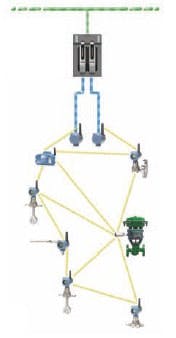The Ultimate in Flexibility
The advent of the wireless instrument network—which in effect moves I/O functionality out into the field device itself—offers perhaps the ultimate in I/O on Demand flexibility. Indeed, once a mesh-based wireless infrastructure is in place, incremental I/O points actually lead to a stronger, more robust wireless network.
So not only does the new I/O point come along "for free," it actually improves the communications reliability of those wireless measurement points around it.
"Wireless has been adopted at thousands of customer sites globally," notes Bob Karschnia, vice president, wireless, for Emerson Process Management. "Plants using wireless have realized savings and become smarter through simpler engineering and construction, flexible start-up, faster deployment and project completion, and the ability to respond to changing automation needs."
But customers have been asking for more, relates Peter Zornio, Emerson chief strategic officer. "In particular, they've requested gateway redundancy and the ability to install gateways in hazardous areas. We've solved both of these issues with the new DeltaV system."
Redundancy + Hazardous Area Installation
Redundancy and hazardous area installation—together with Emerson's new PID algorithm, which makes possible closed-loop control over Wireless HART—will allow more traditionally wired I/O points to go wireless, Emerson believes. This promises to have a profound impact on the design of new facilities as well as the ability of brown-field plants to implement new measurement points and asset management strategies.
"Full redundancy protects the wireless network from any single point of failure by allowing primary failover to ensure that data always is delivered even if there is a malfunction," Karschnia says. "The new full redundancy furthers strengthens Smart Wireless technology as a complement to wired and bus approaches on capital projects."
Wireless redundancy in the new DeltaV architecture takes the form of redundant remote links, which communicate via RS485 with redundant Wireless I/O Cards (WIOCs). The WIOCs, in turn, communicate redundantly with the DeltaV network (Figure 1). This new approach divides the functionality of the existing 1420 Wireless Gateway into two elements, allowing the remote link to be installed in hazardous environments.
"This gives a lot of benefits by increasing availability, reducing both installed cost and footprint, and is more forgiving," says Duncan Schleiss, Emerson vice president of platform strategy. "As with our previous wireless solution, it lowers life-cycle costs and removes the need for engineering drawings."
Wireless PID Enables Closed-loop Control
The latest DeltaV and Smart Wireless offering can also do closed-loop PID control over wireless. At bioprocess technologies supplier Broadley James, wireless pH and temperature transmitters control a single-use disposable bioreactor. "We conducted batch runs using mammalian cell culture," says Scott Broadley, Broadley James president. "The observed pH and temperature control using wireless measurements was equivalent to that achieved using wired transmitters."
Similar results were seen at another installation, this one at the University of Texas, Austin, stripper and absorber control is being done using WirelessHART transmitters. Column pressure control and heater stream flow control over wireless provided the same dynamic response and comparable performance as wired transmitters, according to Frank Seibert, technical manager of the UT Austin separations research program. Both installations use the enhanced PID algorithm available with the DeltaV S-series.
What makes this possible, explains Randy Balentine, DeltaV product marketing manager for Emerson Process Management, is the new control algorithm. "We knew WirelessHART devices and the way they do non-periodic updates, and we understood how we could accommodate that in the PID algorithm and function block," he says. The technology is available to address most control applications, with scan rates as fast as one second, supported by devices, gateway and the DeltaV digital automation system.
"Yesterday, you couldn't do PID wirelessly," says Balentine. "Today, that's no longer the case."
All these wireless enhancements mean that more and more wireless points can be implemented wirelessly—and the savings can add up quickly.
"Up to 44% of process control inputs can be wireless with no difficulty, and for a greenfield plant that's a savings of 7% overall," estimates Schleiss. "Getting rid of wires eliminates most activities associated with wiring design and installation—Poof! Cabinets, wire, terminations, cable tray design, fusing, installation drawings and a host of other activities are simply gone."


